
Original Link: https://www.anandtech.com/show/2109
Patriot Introduces DDR2-1066
In the last couple of months, memory pricing has become a critical concern for many memory shoppers. 2GB of high-end memory, which was available for $300 to $500 in August, had escalated to $600, $700 or even more at many memory resellers. Buyers who wanted to buy the best DDR2 memory they could find have found themselves asking if cheaper memory would meet their needs.
There is some good news today, as memory prices appear to be coming down. This will impact system price for many buyers, and we can only hope that memory prices continue to drop and remain low through the holiday buying season and beyond. The price of memory has been a critical factor in today's review of Patriot DDR2-1066. Memory rated higher than DDR2-800 has been particularly hard hit by high prices. As the best of the lot, the high-end memory demanded the highest prices.
We don't normally quote prices in reviews, because the information is stale the moment it is published. However, memory price is such a big concern the point needs to be made that today you can find this top-of-the-line Patriot DDR2-1066 from online e-tailers for as little as $375 (after rebate) for the 2 GB kit. The 1GB kit is even less. Other high-end memory is also dropping in price, so it's a good idea to check the price of that high-end memory again before you settle for second or third choice in your system.
As we have stated in many recent reviews, DDR2-667 and DDR2-800 will certainly meet the needs of most system buyers. Both memories will normally perform at DDR2-800 in Intel and AM2 systems and overclock modestly beyond that point. However, we have also stated that we have never found a memory rated at DDR2-667 that could reach DDR2-1000 or a DDR2-800 that can reach DDR2-1066. On the other hand, every memory rated at DDR2-1000 or above has reached DDR2-1067, with most approaching DDR2-1100 or more at the top. We point this out because memory performance does continue to improve to DDR2-1066 at the timings these memory modules can achieve. Beyond 1066, timings deteriorate fast and are not so useful, but DDR2-1066 is a useful speed that performs better in most systems than slower speed memory. The performance difference is not earth-shaking, and frankly you get a better bang-for-your-buck spending more on an upgraded video card than faster memory in most systems. However, the fastest memory does perform better, and if you want the best you will be looking for the fastest memory you can afford.
Patriot is the brand name division of PDP, which is a huge memory manufacturer in Freemont, CA. We mention this only so you will understand that Patriot is likely already making some of the high-end memory names you know and trust. For that reason, the Patriot brand already comes with a built-in confidence and trust of specifications that are rarely warranted by little-known memory brands. Patriot may not be a brand that is widely recognized, but it is manufactured using similar testing procedures and controls of high-end memory brands you do know and trust.
With a speed rating of DDR2-1066 - one of the highest rated speeds we have seen - and a manufacturer well-known in the high-end OEM memory industry, expectations were high for Patriot DDDR2-1066. The current price of $375 for a 2GB kit of DDR2-1066 made it that much more attractive for buyers weary of super-high memory prices. The big question, then, is whether the Patriot PDC22G8500ELK lived up to those expectations?
Patriot DDR2-1066 Memory Specifications
Patriot is a division of PDP Systems, with headquarters in Fremont, CA. Patriot has sales offices throughout the US and Asia, and distributes memory in North America, Europe, Asia, the Middle East, Africa and Latin America. Patriot produces memory modules and flash memory in several product lines including Extreme Performance (EP) and Signature Lines (SL).
While the Patriot brand may not be recognized by some of our readers, the odds are that you have used a Patriot manufactured memory if you been a hobbyist or in the PC market for a while. Patriot is a leading OEM manufacturer, so they manufacture memory modules for many other companies. With the recent company push toward their own branding, the Patriot name represents PDP's own direct marketing of memory products.
All Patriot EP, DC, and SL product lines are manufactured in Fremont, CA and distributed throughout most of the world. Patriot claims 100% testing of their high-end EP products, such as the PC2-8500 tested in this review. EP memory also comes with a lifetime repair or replacement warranty, which is comparable to other top high-end memory.
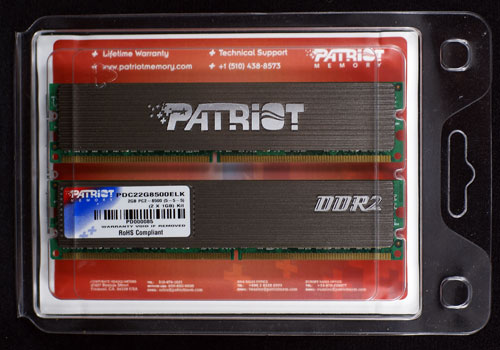
Red and Black are the Patriot memory colors. You see them used together in packaging and heatsink colors for the DDR2-1066 being tested. The PC2-8500 packaging is a common clam-shell package with a bright red insert and memory with black heatspreaders.
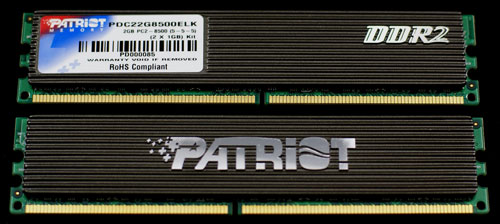
The PDC22GB8500ELK was supplied as a 2GB kit with a matched pair of 1GB DIMMs. The DIMMs feature black aluminum heatspreaders with red, white, and blue labeling. The bladed heatshields provide more surface area for cooling, and the Patriot logo is a raised brushed aluminum. The DIMMs and packaging do a good job of conveying a professional image with the Patriot brand name. The Patriot website provides detailed information about the Patriot product line at www.patriotmemory.com. Support is provided for configuring and testing memory. RMA forms and procedures are also available under the Support tab.
| Patriot PDC22G8500ELK Memory Specifications | |
| Number of DIMMs & Banks | 2 DS |
| DIMM Size | 1GB |
| Total Memory | 2 GB |
| Rated Timings | 5-5-5-9 at DDR2-1066 |
| Rated Voltage | 2.3V |
The memory kit being tested is a 2GB kit - 2x1GB DIMMs. Patriot DDR2-1066 is also available as a 1GB kit consisting of 2x512MB DIMMs. With memory prices still high in today's market, the availability of a cheaper 1GB dual-channel kit may be important to some buyers.
Memory Test Configuration
DDR2 memory performance, in timings and required voltage, are equivalent on the AM2 and Core 2 Duo platforms. This was clearly illustrated in Conroe vs. AM2: Memory & Performance. The first generation of AM2 on-processor memory controller, however, does not support any memory timings below 3, while the Intel platform supports 2 settings for RAS-to-CAS and RAS Precharge. In addition AM2 boards do not currently support DDR2-1067 as a memory speed option, which makes it more difficult to test the newest DDR2 memories rated at DDR2-1000, DDR2-1067, DDR2-1100, or even higher.
For all of these reasons, the Intel platform is the current AnandTech test platform for DDR2 memory. The Core 2 Duo Extreme processor, which has available CPU ratios both up and down, is the platform of choice. When changes are made in future AMD and Intel products the memory test platform will be examined again.
The Asus P5W-DH is the latest 975X board in the Asus family and it fully supports the Core 2 processors. The P5W-DH Deluxe therefore replaced the P5W-D2-E Premium used in past DDR2 reviews. A review of the updated Asus P5W-DH Deluxe is available in the Conroe Buyers Guide.
The P5W-DH features similar memory options to the earlier versions. Since most of the Core 2 Duo/Extreme processors run at a quad-pumped FSB of 1067 (base 266), the available options at FSB1067 are particularly useful for benchmarking memory when a Core 2 chip powers the system.
| Memory Configuration Options/ASUS P5W-DH Deluxe Motherboard | ||||||||
| Auto | DDR2-400 | DDR2-533 | DDR2-667 | DDR2-711* | DDR2-800* | DDR2-889* | DDR2-1067* | |
| FSB-1067 | X | X | X | X | X | X | X | X |
| FSB-800 | X | X | X | X | X | |||
| FSB-533 | X | X | X | |||||
The memory test bench uses the following components:
| Memory Performance Test Configuration | |
| Processor | Intel Core 2 Duo X6800 (x2, 2.93GHz, 4MB Unified Cache) |
| RAM | 2x1GB Patriot DDR2-1066 2x1GB Super Talent DDR2-1000 2x1GB TEAM DDR2-1000 2 x 1GB Corsair CM2X1024-6400C3 2x1GB OCZ Ti Alpha PC2-8000 VX2 |
| Hard Drive | Hitachi 250GB SATA2 enabled (16MB Buffer) |
| Video Card | 1 x EVGA 7900GTX - All Standard Tests |
| Video Drivers | NVIDIA 91.47 |
| CPU Cooling | Tuniq Tower 120 |
| Power Supply | OCZ PowerStream 520W |
| Motherboard | ASUS P5W-DH Deluxe (Intel 975X) |
| Operating System | Windows XP Professional SP2 |
| BIOS | AMI 1407 (October 2, 2006) |
Comparing benchmarks with Conroe to older results with Intel Presler processors does not really reveal much about memory performance. Core 2 Duo is as much as 35 to 40% faster than Presler, which distorts memory performance benchmark performance. For that reason the only results shown in this review are DDR2 memories tested on the X6800 (Core 2 Duo) platform. Previously reported timings and voltages are still useful and can be compared to previous results, but performance results on Core 2 are the only DDR2 test results reported in this review.
Stock Memory Performance
Most Intel processor motherboards provide a wide range of memory ratios that match available DDR2 memory. End-users can select the memory ratio that matches their DDR2 memory speed. Our memory testing begins with the same approach. We first test all of the stock ratios at the fastest stable timings we can achieve at the given ratio. With ratios, CPU speed remains the same at 2.93GHz in our memory test bed, and memory speed is varied by selecting different ratios.
There are some downsides to this approach. With the memory controller in the chipset, instead of part of the processor as in AM2 systems, there is a small performance penalty for speeds other than a 1:1 ratio (DDR2-533 in this case). However the real performance penalty is very small and memory scales nicely through the various speed options.
 |
| Click to enlarge |
DDR2 memory is then pushed from the highest stock ratio that could be achieved in testing - in this case 1067 - to the highest FSB speed at the stock multiplier. Patriot reached a stable speed of 1092, which is below the fastest DDR2 speed we have tested, but still very close to the DDR2-1100 that represents the best level of performance we have achieved. Put into perspective 1092 is 273 quad-pumped at a 1067 ratio; our highest ever 1116 is a quad-pumped 279. As you will see in later graphs comparing performance, the real performance difference between 1092 and 1116 is extremely small.
Having said that, DDR2-1066 is the highest rated memory speed we have tested and published in a review. With such a high rated speed we really thought we might reach 1120+, but once again we learned that memory based on Micron chips performs very similarly despite the rated speed.
Looking more closely at the results, the Patriot was a top-performer at every rated speed, including 1066. Performance at DDR2-400, 533, 667, 800, and 1066 were as good as we have found in any DDR2 memory. Timings were also a dead-ringer match to the best we have seen from other high-end DDR2 memory. This will be an important finding for those shopping for high-end DDR2 memory. The only negative we found in comparing this Patriot was that it did require a bit more voltage at most speeds than the very best. However, in every case the same aggressive timings could be reached with the Patriot DDR2-1066, only with a bit more voltage.
You can also disregard the extremely conservative ratings of 5-5-5-9 at 2.3V at DDR2-1066. In our performance testing DDR2-1066 was completely stable at 4-3-4-11 at 2.30V. This is more in line with the best DDR2 memory.
Memory Bandwidth Scaling
Memory bandwidth normally improves with increases in memory speed and reductions in memory timings. This is best illustrated using Performance Scaling charts instead of the bar charts for individual speeds that were used in past memory reviews. We first began using Performance Scaling Charts to show memory performance in our comparison of DDR2 memory on AM2 and Core 2 Duo processors.
Since the results for high-end memory were so close at all tested speeds, the scale range was reduced to better show the small differences in these memory benchmark results. Please keep this in mind when viewing the charts, since a normal zero scale would make performance differences appear much smaller than these expanded scale charts. Values for Patriot memory at each speed are included below each chart for reference.
To evaluate memory bandwidth SiSoft Sandra 2007 Professional was used to provide a closer look at scaling for fast DDR2 memory.
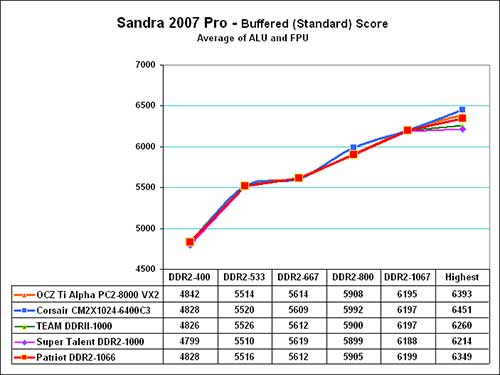 |
| Click to enlarge |
The most widely reported Sandra score is the Standard or Buffered memory score. This benchmark takes into account the buffering schemes like MMX, SSE, SSE2, SSE3, and other buffering tools that are used to improve memory performance. Buffered bandwidth performance of the Patriot memory was virtually the same as the previously tested Corsair and OCZ throughout the test curve.
The Buffered benchmark does not correlate well with real performance differences in games or other applications, so our memory bandwidth tests have always included an Unbuffered Sandra memory score. The Unbuffered result turns off the buffering schemes, and we have found the differences in the Unbuffered results correlate well with real-world performance differences.
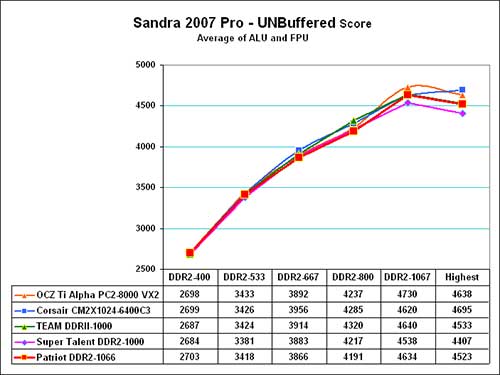 |
| Click to enlarge |
In Unbuffered tests we see the Patriot pretty much mirrors the Corsair 6400C3 and OCZ PC2-8000 to DDR2-1067. This is another way of saying Patriot performance is comparable to the best high-end DDR2 we have tested. The Super Talent, which requires slightly slower timings at many speeds, is a little lower on bandwidth than the other four. At the Highest speeds the OCZ and Corsair top the bandwidth, as we would expect from the better overclocking these memories exhibit.
We also compared results with Version 1.5 of SuperPi - comparing the time to calculate 2 million places of Pi at the different memory speeds. This benchmark measures pure number crunching.
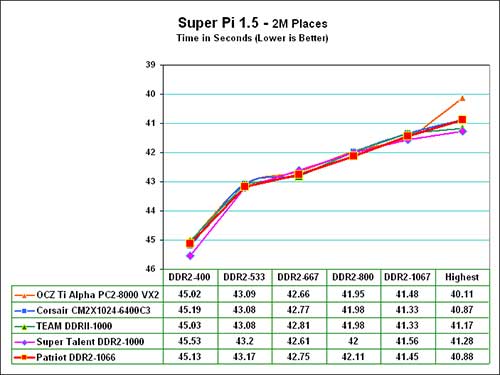 |
| Click to enlarge |
SuperPi results continue to improve all the way to the highest speed that could be reached with stability with each memory. That is a result that will surprise many advocates of the "memory speed doesn't matter" school. The second result that stands out is how very close the results with OCZ, Corsair, TEAM and Patriot really are. All 5 memories perform very similarly with just the Super Talent dropping off a bit at the top and bottom due to slightly slower timings. While performance is very close, SuperPi scaling charts show the useful sensitivity of SuperPi as a measurement of memory performance
Game Performance Comparison
Real-world benchmarks - specifically gaming benchmarks - provide the most useful measure of memory performance if you keep in mind what they represent. Memory is just one small part of overall system performance, and the AT benchmarks keep everything the same except memory speed. Even the CPU speed is kept constant (except for the overclocking test). As a result performance improvements in FPS are very small because the only factor influencing the test results is memory speed. Many factors affect system performance, and memory speed is just one of those factors.
Results for high-end memory were very close at tested speeds. Therefore, the scale range was reduced to better show the small differences in these memory benchmark results at each speed. Please keep this in mind when viewing the charts. A normal zero scale would make performance differences appear much smaller than these expanded scale charts. Values for Patriot memory at each speed are included below each chart for reference.
The AT memory test suite uses Far Cry, Half-Life 2 and Quake 4 for memory testing because they are sensitive to memory performance.
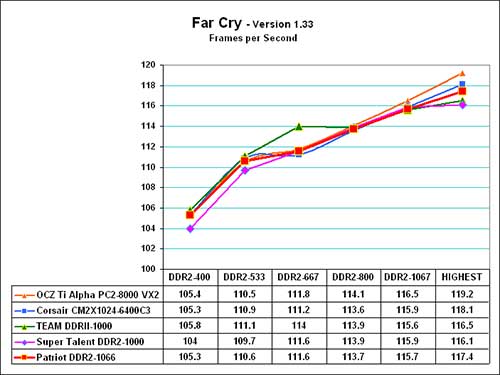 |
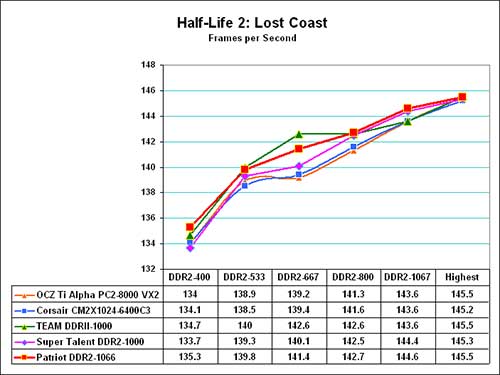 |
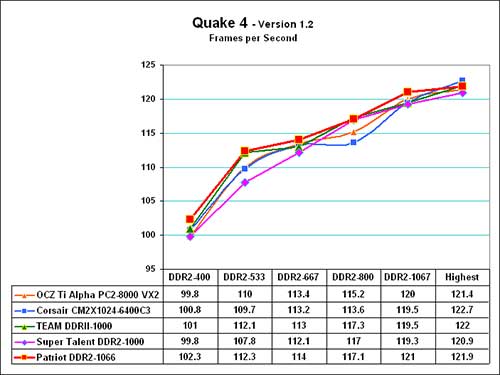 |
| Click to enlarge |
All three games continue to show improvement in frame rates as memory speed increases, even though timings are looser the faster we go. Put another way, performance continues to improve as memory speed increases - to DDR2-1067 and a bit beyond. The Patriot performance was comparable to OCZ, Corsair, and TEAM. Super Talent is on the bottom of the scaling chart at DDR2-533 since it requires a 3 RAS-to-CAS setting at slower memory speeds, while the other four memories are stable at a 2 setting. Super Talent is also a bit slower at the top. The performance differences between the five tested memories are admittedly very small - but still measurable. Memory speed can definitely improve system performance, but not to the extent of an upgraded video card or a higher speed processor.
Overclocking Performance (Highest Ratio at Highest Speed)
The Patriot DDR2-1067 performed extremely well to its rated speed of DDR2-1066. Above that speed, we found limited headroom, with the highest stable speed of DDR2-1092. This is not a record overclock, but it is certainly in the ball park with other top memory based on Micron memory chips, which generally reach around DDR2-1100, depending on binning by the memory manufacturer.
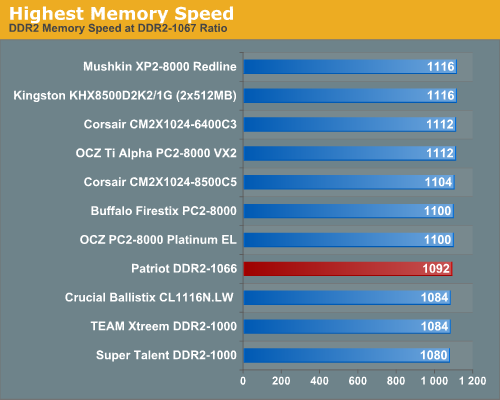
The timings required by the Patriot were the same as we found on the very best DDR2 memory, with slightly higher voltages required for the same performance levels. Overall, the Patriot definitely belongs in the elite group of DDR2 memory that represents the best we have tested.
Final Words
Micron D9 memory chips continue to set the pace for high-end DDR2 memory performance. Because Micron D9 remains the best, it is good for buyers that we are seeing these excellent memory chips used in more memory brands. Wider availability opens the door for the best memory value when shopping for high-end memory.
A good example is today's Patriot DDR2-1066 2GB memory kit. At a current web price of $375 after rebate you will get good value with this top-end memory, and you also will get performance very competitive with the best DDR2 memory you can buy. You should also check pricing for other top-end memory based on the Micron chips, since memory prices are finally coming back down. You may find that memory brands that were too pricey just a few days ago are also much cheaper to buy today as memory prices continue to fall.
Our first encounter with Micron D9 memory chips came with the OCZ EL PC2-8000 XTC in early spring. We were impressed with the performance then, and our admiration for the performance capabilities of this DDR2 chip has only grown since. This was the fastest DDR2 memory ever tested at AnandTech, and it continues to hold that title.
We have recently evaluated other memory modules that are rated at even higher memory speeds than the Micron D9 we have reviewed. However, these high-spec'ed modules would, in most cases, only run at the highest speeds on the Intel P965 platform, and not in our Intel 975X platform. It appears the P965 is not generally as demanding as the Asus P5W-DH 975X in memory, so we get situations where performance of memory on the 975X at say DDDR2-1066 are sometimes even higher than a P965 at DDR2-1150. This review is not the platform for exploring this, but we do intend to explore this in a future memory review. For now we can say that whatever we find on the Asus P5W-DH memory test bed will likely be the very minimum you can expect if running the same memory on a P965 platform - at least as far as memory speed is concerned.
The Patriot DDR2-1066 is a fine product. It significantly exceeds the published specifications of DDR2-1066 of 5-5-5-9 at 2.3V. At the DDR2-1066 speed we managed a stable system with 4-3-4-11 timings at 2.3V. These test results are the same at 1066 as the best DDR2 memory we have tested. From DDR2-400 to DDR-533, DDR2-800, and DDR2-1066 the Patriot performed on par with the best. It equaled the best DDR2 memory we have tested across the bandwidth.
While you will not find headroom to reach DDR2-1100 and higher, the Patriot does reach a stable DDR2-1092, and performance at that speed is very comparable to top performance on brands reaching DDR2-1100 and more. We also suspect if our memory test bed had adjustments for memory voltage above 2.4V we may have reached even higher overclocks.
Overall, PDP has produced a very competitive product in their Patriot DDR2-1066. It exceeds published specs and performs the same as the best DDR2 memory we have tested. It is also a good value when it comes to selling price. You should definitely consider this Patriot DDR2-1066 if you are shopping for top DDR2-1066 memory. If you find the Patriot represents the best value of the brands you are considering, you can buy it without worrying about compromises in performance.







